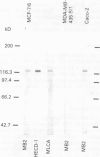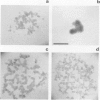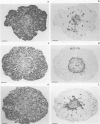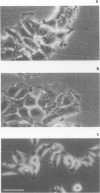Abstract
The calcium-dependent cell-cell adhesion molecule E-cadherin has been shown to counteract invasion of epithelial neoplastic cells. Using three monoclonal antibodies, we have demonstrated the presence of E-cadherin at the surface of human MCF-7/6 mammary carcinoma cells by indirect immunofluorescence coupled to flow cytometry and by immunocytochemistry. Nevertheless, MCF-7/6 cells failed to aggregate in a medium containing 1.25 mM CaCl2, and they were invasive after confrontation with embryonic chick heart fragments in organ culture. Treatment of MCF-7/6 cells with 0.5 microgram ml-1 insulin-like growth factor I (IGF-I) led to homotypic aggregation within 5 to 10 min and inhibited invasion in vitro during at least 8 days. The effect of IGF-I on cellular aggregation was insensitive to cycloheximide. However, monoclonal antibodies that interfered with the function of either the IGF-I receptor (alpha IR3) or E-cadherin (HECD-1, MB2) blocked the effect of IGF-I on aggregation. The effects of IGF-I on aggregation and on invasion could be mimicked by 1 microgram ml-1 insulin, but not by 0.5 microgram ml-1 IGF-II. The insulin effects were presumably not mediated by the IGF-I receptor, since they could not be blocked by an antibody against this receptor (alpha IR3). Our results indicate that IGF-I activates the invasion suppressor role of E-cadherin in MCF-7/6 cells.
Full text
PDF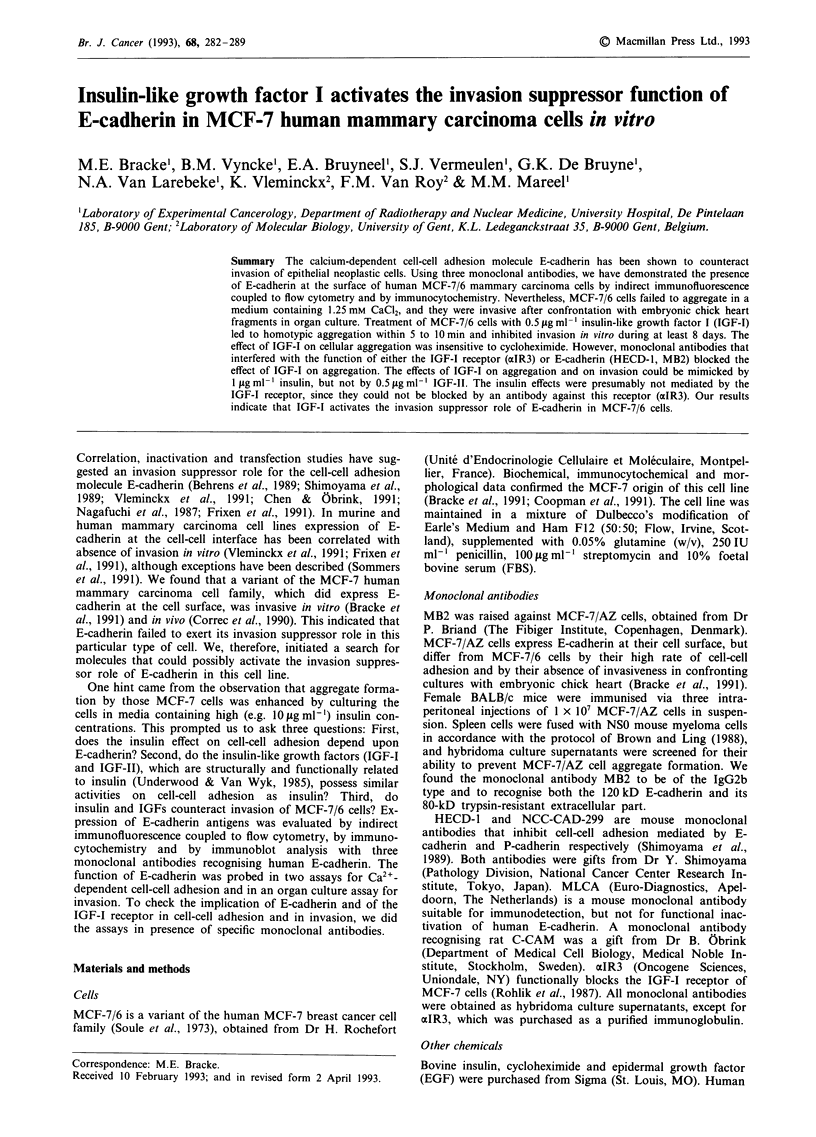

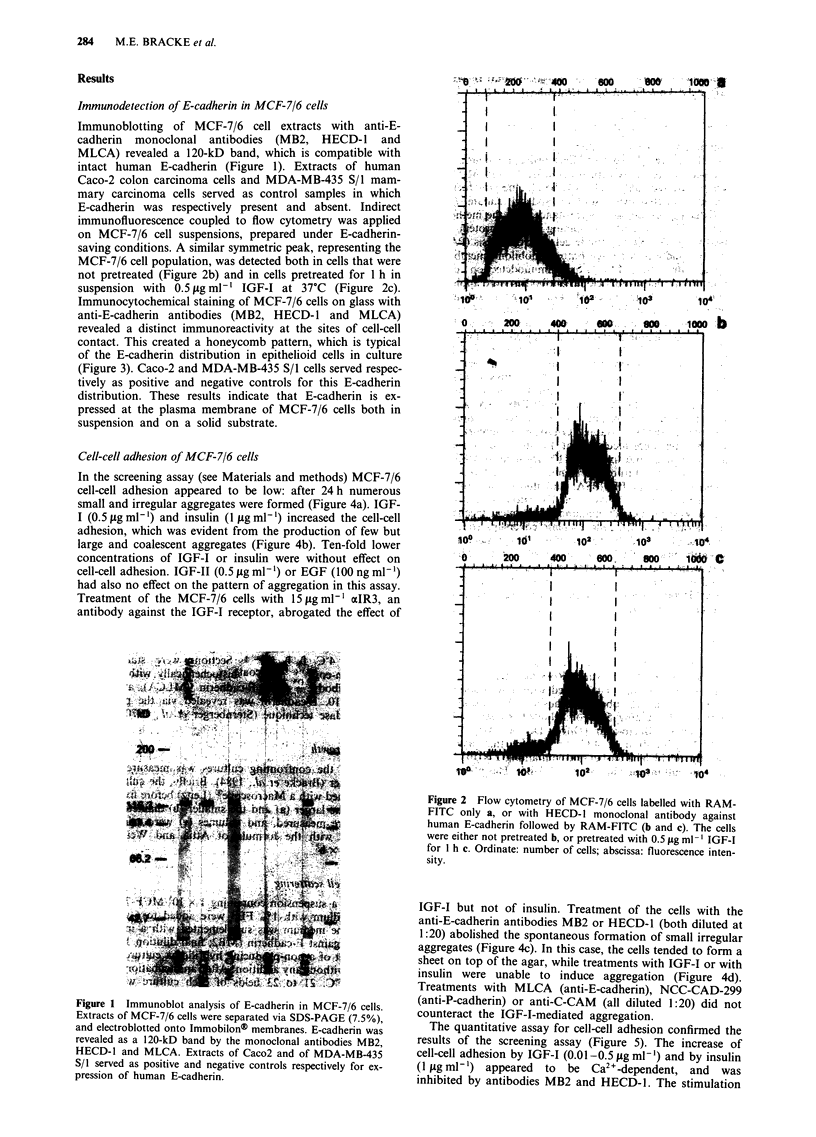
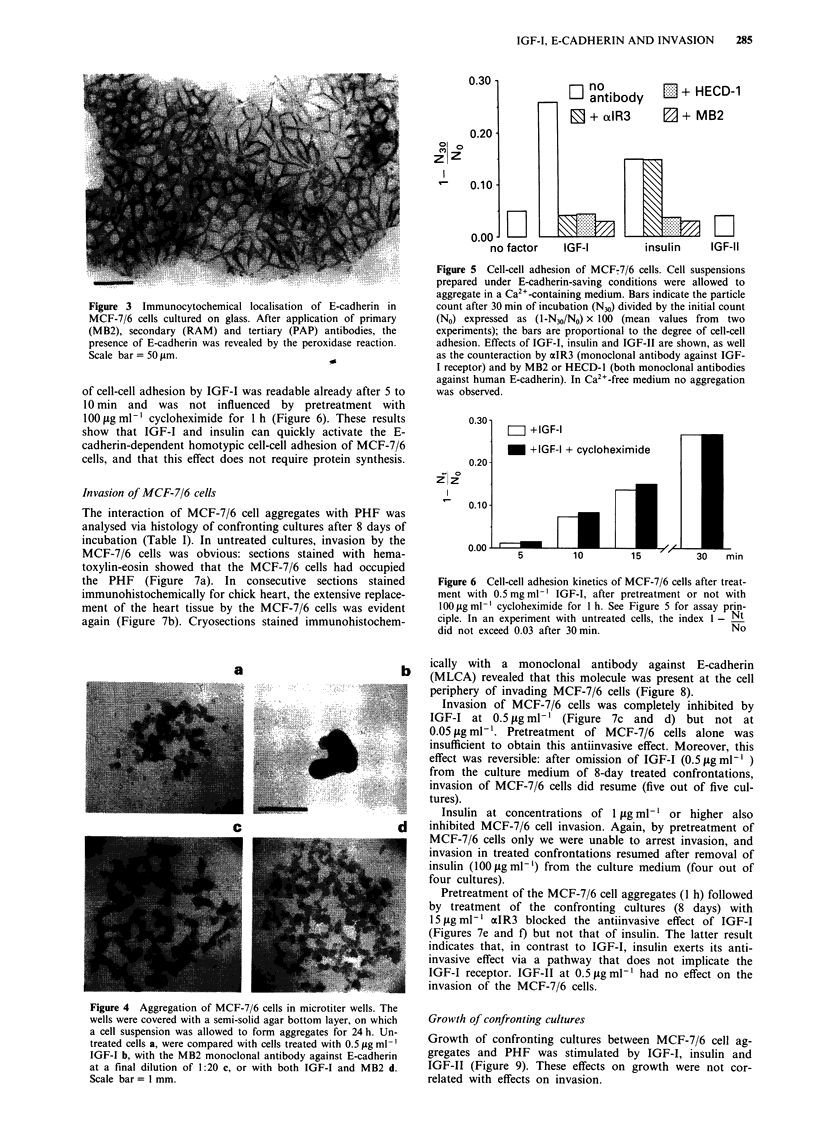
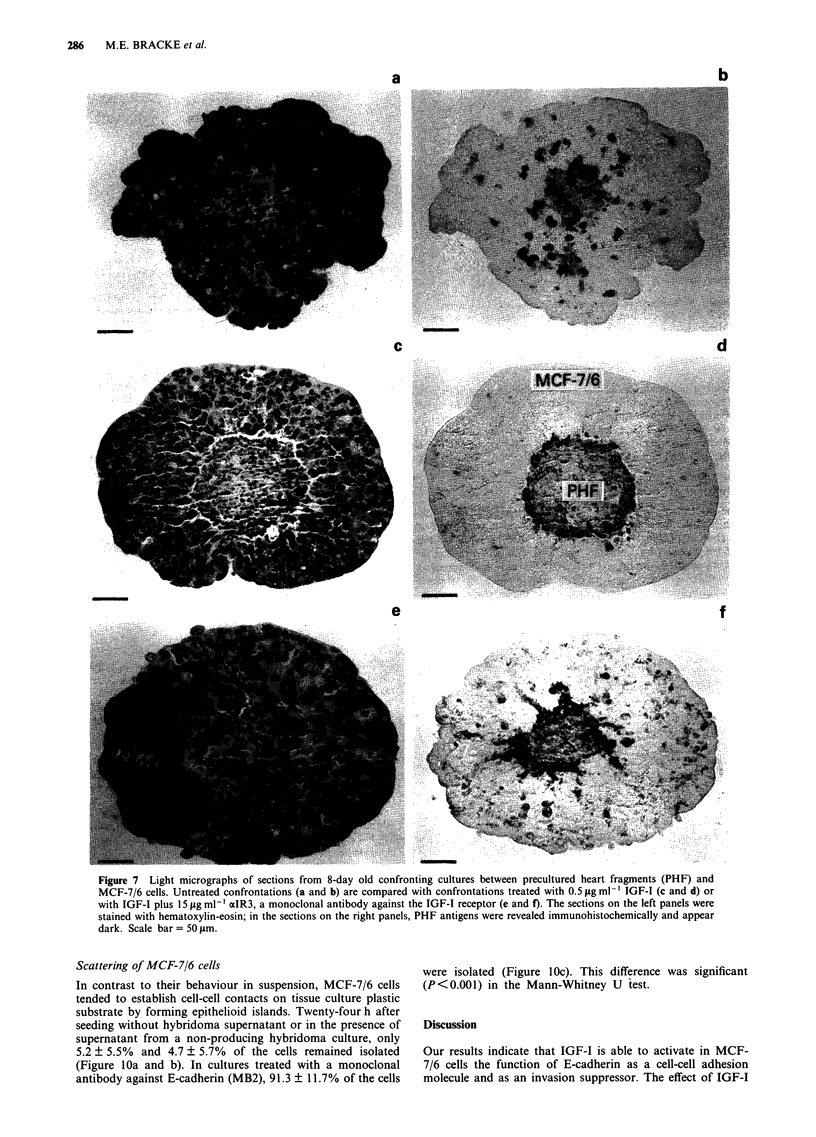
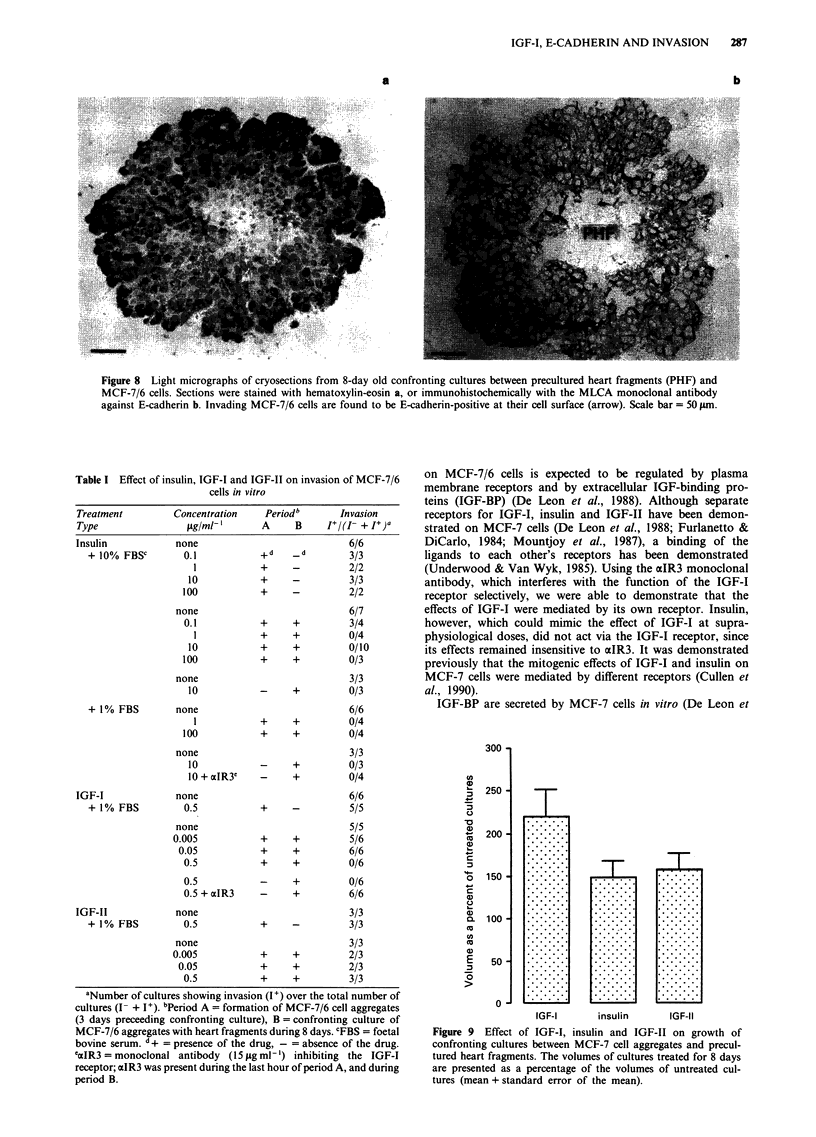
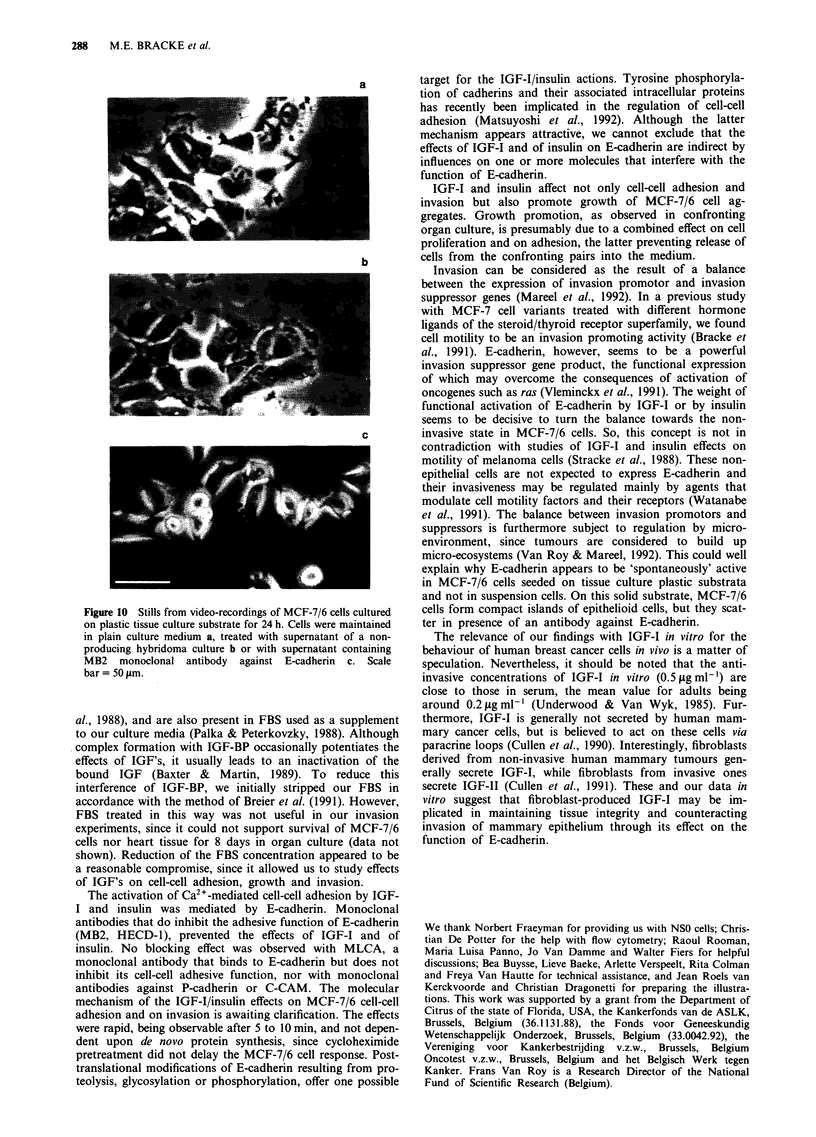
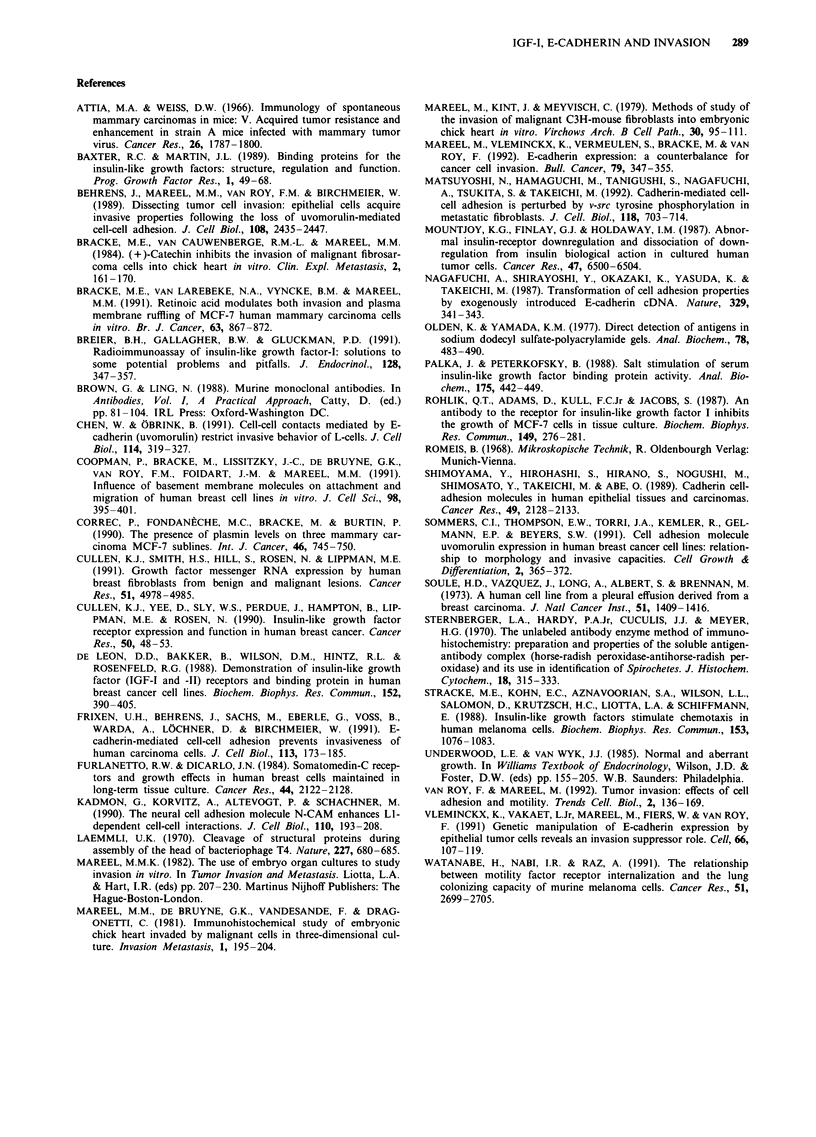
Images in this article
Selected References
These references are in PubMed. This may not be the complete list of references from this article.
- Attia M. A., Weiss D. W. Immunology of spontaneous mammary carcinomas in mice. V. Acquired tumor resistance and enhancement in strain A mice infected with mammary tumor virus. Cancer Res. 1966 Aug;26(8):1787–1800. [PubMed] [Google Scholar]
- Baxter R. C., Martin J. L. Binding proteins for the insulin-like growth factors: structure, regulation and function. Prog Growth Factor Res. 1989;1(1):49–68. doi: 10.1016/0955-2235(89)90041-0. [DOI] [PubMed] [Google Scholar]
- Behrens J., Mareel M. M., Van Roy F. M., Birchmeier W. Dissecting tumor cell invasion: epithelial cells acquire invasive properties after the loss of uvomorulin-mediated cell-cell adhesion. J Cell Biol. 1989 Jun;108(6):2435–2447. doi: 10.1083/jcb.108.6.2435. [DOI] [PMC free article] [PubMed] [Google Scholar]
- Bracke M. E., Van Cauwenberge R. M., Mareel M. M. (+)-Catechin inhibits the invasion of malignant fibrosarcoma cells into chick heart in vitro. Clin Exp Metastasis. 1984 Apr-Jun;2(2):161–170. doi: 10.1007/BF00052416. [DOI] [PubMed] [Google Scholar]
- Bracke M. E., Van Larebeke N. A., Vyncke B. M., Mareel M. M. Retinoic acid modulates both invasion and plasma membrane ruffling of MCF-7 human mammary carcinoma cells in vitro. Br J Cancer. 1991 Jun;63(6):867–872. doi: 10.1038/bjc.1991.191. [DOI] [PMC free article] [PubMed] [Google Scholar]
- Breier B. H., Gallaher B. W., Gluckman P. D. Radioimmunoassay for insulin-like growth factor-I: solutions to some potential problems and pitfalls. J Endocrinol. 1991 Mar;128(3):347–357. doi: 10.1677/joe.0.1280347. [DOI] [PubMed] [Google Scholar]
- Chen W. C., Obrink B. Cell-cell contacts mediated by E-cadherin (uvomorulin) restrict invasive behavior of L-cells. J Cell Biol. 1991 Jul;114(2):319–327. doi: 10.1083/jcb.114.2.319. [DOI] [PMC free article] [PubMed] [Google Scholar]
- Coopman P. J., Bracke M. E., Lissitzky J. C., De Bruyne G. K., Van Roy F. M., Foidart J. M., Mareel M. M. Influence of basement membrane molecules on directional migration of human breast cell lines in vitro. J Cell Sci. 1991 Mar;98(Pt 3):395–401. doi: 10.1242/jcs.98.3.395. [DOI] [PubMed] [Google Scholar]
- Correc P., Fondanèche M. C., Bracke M., Burtin P. The presence of plasmin receptors on three mammary carcinoma MCF-7 sublines. Int J Cancer. 1990 Oct 15;46(4):745–750. doi: 10.1002/ijc.2910460432. [DOI] [PubMed] [Google Scholar]
- Cullen K. J., Smith H. S., Hill S., Rosen N., Lippman M. E. Growth factor messenger RNA expression by human breast fibroblasts from benign and malignant lesions. Cancer Res. 1991 Sep 15;51(18):4978–4985. [PubMed] [Google Scholar]
- Cullen K. J., Yee D., Sly W. S., Perdue J., Hampton B., Lippman M. E., Rosen N. Insulin-like growth factor receptor expression and function in human breast cancer. Cancer Res. 1990 Jan 1;50(1):48–53. [PubMed] [Google Scholar]
- De Leon D. D., Bakker B., Wilson D. M., Hintz R. L., Rosenfeld R. G. Demonstration of insulin-like growth factor (IGF-I and -II) receptors and binding protein in human breast cancer cell lines. Biochem Biophys Res Commun. 1988 Apr 15;152(1):398–405. doi: 10.1016/s0006-291x(88)80727-7. [DOI] [PubMed] [Google Scholar]
- Frixen U. H., Behrens J., Sachs M., Eberle G., Voss B., Warda A., Löchner D., Birchmeier W. E-cadherin-mediated cell-cell adhesion prevents invasiveness of human carcinoma cells. J Cell Biol. 1991 Apr;113(1):173–185. doi: 10.1083/jcb.113.1.173. [DOI] [PMC free article] [PubMed] [Google Scholar]
- Furlanetto R. W., DiCarlo J. N. Somatomedin-C receptors and growth effects in human breast cells maintained in long-term tissue culture. Cancer Res. 1984 May;44(5):2122–2128. [PubMed] [Google Scholar]
- Kadmon G., Kowitz A., Altevogt P., Schachner M. The neural cell adhesion molecule N-CAM enhances L1-dependent cell-cell interactions. J Cell Biol. 1990 Jan;110(1):193–208. doi: 10.1083/jcb.110.1.193. [DOI] [PMC free article] [PubMed] [Google Scholar]
- Laemmli U. K. Cleavage of structural proteins during the assembly of the head of bacteriophage T4. Nature. 1970 Aug 15;227(5259):680–685. doi: 10.1038/227680a0. [DOI] [PubMed] [Google Scholar]
- Mareel M. M., De Bruyne G. K., Vandesande F., Dragonetti C. Immunohistochemical study of embryonic chick heart invaded by malignant cells in three-dimensional culture. Invasion Metastasis. 1981;1(3):195–204. [PubMed] [Google Scholar]
- Mareel M., Kint J., Meyvisch C. Methods of study of the invasion of malignant C3H-mouse fibroblasts into embryonic chick heart in vitro. Virchows Arch B Cell Pathol Incl Mol Pathol. 1979 May 4;30(1):95–111. doi: 10.1007/BF02889094. [DOI] [PubMed] [Google Scholar]
- Mareel M., Vleminckx K., Vermeulen S., Bracke M., Van Roy F. E-cadherin expression: a counterbalance for cancer cell invasion. Bull Cancer. 1992;79(4):347–355. [PubMed] [Google Scholar]
- Matsuyoshi N., Hamaguchi M., Taniguchi S., Nagafuchi A., Tsukita S., Takeichi M. Cadherin-mediated cell-cell adhesion is perturbed by v-src tyrosine phosphorylation in metastatic fibroblasts. J Cell Biol. 1992 Aug;118(3):703–714. doi: 10.1083/jcb.118.3.703. [DOI] [PMC free article] [PubMed] [Google Scholar]
- Mountjoy K. G., Finlay G. J., Holdaway I. M. Abnormal insulin-receptor down regulation and dissociation of down regulation from insulin biological action in cultured human tumor cells. Cancer Res. 1987 Dec 15;47(24 Pt 1):6500–6504. [PubMed] [Google Scholar]
- Nagafuchi A., Shirayoshi Y., Okazaki K., Yasuda K., Takeichi M. Transformation of cell adhesion properties by exogenously introduced E-cadherin cDNA. Nature. 1987 Sep 24;329(6137):341–343. doi: 10.1038/329341a0. [DOI] [PubMed] [Google Scholar]
- Olden K., Yamada K. M. Direct detection of antigens in sodium dodecyl sulfate-polyacrylamide gels. Anal Biochem. 1977 Apr;78(2):483–490. doi: 10.1016/0003-2697(77)90108-7. [DOI] [PubMed] [Google Scholar]
- Palka J., Peterkofsky B. Salt stimulation of serum insulin-like growth factor binding protein activity. Anal Biochem. 1988 Dec;175(2):442–449. doi: 10.1016/0003-2697(88)90568-4. [DOI] [PubMed] [Google Scholar]
- Rohlik Q. T., Adams D., Kull F. C., Jr, Jacobs S. An antibody to the receptor for insulin-like growth factor I inhibits the growth of MCF-7 cells in tissue culture. Biochem Biophys Res Commun. 1987 Nov 30;149(1):276–281. doi: 10.1016/0006-291x(87)91635-4. [DOI] [PubMed] [Google Scholar]
- Shimoyama Y., Hirohashi S., Hirano S., Noguchi M., Shimosato Y., Takeichi M., Abe O. Cadherin cell-adhesion molecules in human epithelial tissues and carcinomas. Cancer Res. 1989 Apr 15;49(8):2128–2133. [PubMed] [Google Scholar]
- Sommers C. L., Thompson E. W., Torri J. A., Kemler R., Gelmann E. P., Byers S. W. Cell adhesion molecule uvomorulin expression in human breast cancer cell lines: relationship to morphology and invasive capacities. Cell Growth Differ. 1991 Aug;2(8):365–372. [PubMed] [Google Scholar]
- Soule H. D., Vazguez J., Long A., Albert S., Brennan M. A human cell line from a pleural effusion derived from a breast carcinoma. J Natl Cancer Inst. 1973 Nov;51(5):1409–1416. doi: 10.1093/jnci/51.5.1409. [DOI] [PubMed] [Google Scholar]
- Sternberger L. A., Hardy P. H., Jr, Cuculis J. J., Meyer H. G. The unlabeled antibody enzyme method of immunohistochemistry: preparation and properties of soluble antigen-antibody complex (horseradish peroxidase-antihorseradish peroxidase) and its use in identification of spirochetes. J Histochem Cytochem. 1970 May;18(5):315–333. doi: 10.1177/18.5.315. [DOI] [PubMed] [Google Scholar]
- Stracke M. L., Kohn E. C., Aznavoorian S. A., Wilson L. L., Salomon D., Krutzsch H. C., Liotta L. A., Schiffmann E. Insulin-like growth factors stimulate chemotaxis in human melanoma cells. Biochem Biophys Res Commun. 1988 Jun 30;153(3):1076–1083. doi: 10.1016/s0006-291x(88)81338-x. [DOI] [PubMed] [Google Scholar]
- Van Roy F., Mareel M. Tumour invasion: effects of cell adhesion and motility. Trends Cell Biol. 1992 Jun;2(6):163–169. doi: 10.1016/0962-8924(92)90035-l. [DOI] [PubMed] [Google Scholar]
- Vleminckx K., Vakaet L., Jr, Mareel M., Fiers W., van Roy F. Genetic manipulation of E-cadherin expression by epithelial tumor cells reveals an invasion suppressor role. Cell. 1991 Jul 12;66(1):107–119. doi: 10.1016/0092-8674(91)90143-m. [DOI] [PubMed] [Google Scholar]
- Watanabe H., Nabi I. R., Raz A. The relationship between motility factor receptor internalization and the lung colonization capacity of murine melanoma cells. Cancer Res. 1991 May 15;51(10):2699–2705. [PubMed] [Google Scholar]



